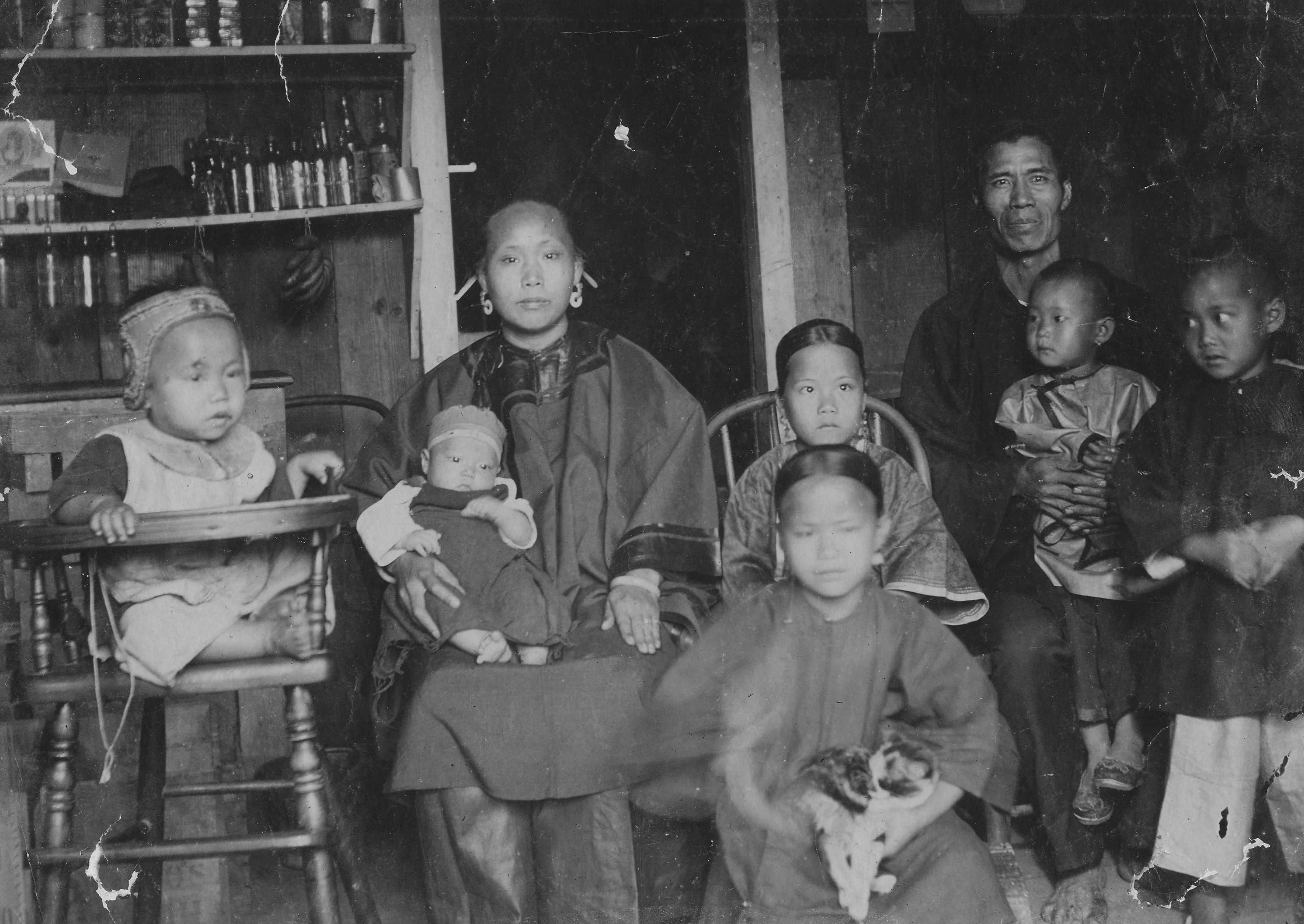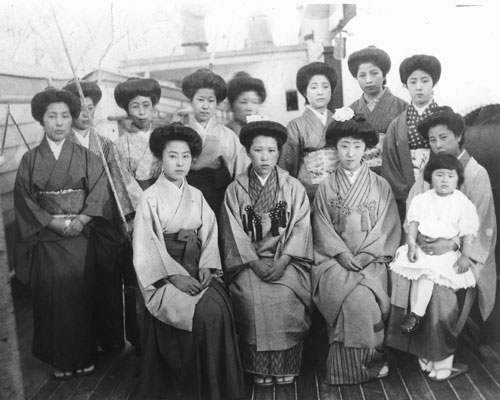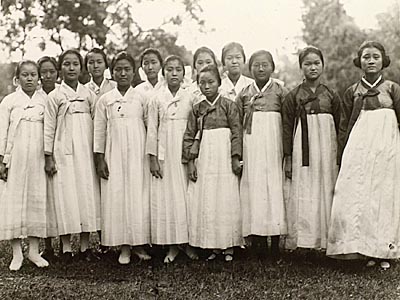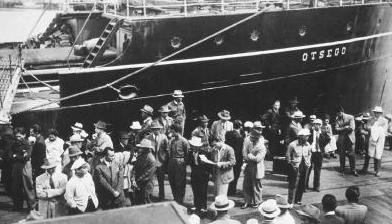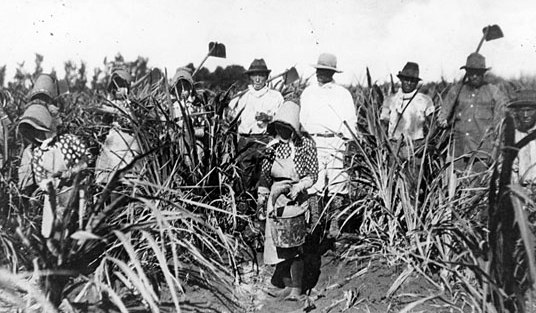|
Immigration to
Hawaii County,
Hawaii |
|
Hawaii County HIGenWeb a proud part of
County
Coordinator |
If you have any additions or corrections please contact me
|
OVERVIEW:
(source:
http://www.loc.gov/teachers/classroommaterials/presentationsandactivities/presentations/immigration/japanese2.html) Further details: (source: http://www.hawaiian-roots.com/immigrants.htm):
Chinese The first group of indentured Chinese plantation workers arrived in 1852. Between 1852 and 1856, several thousand Chinese were brought in to labor on the plantations. By 1884, this number had risen to 18,254. The Chinese people who migrated to Hawaii were mostly Cantonese from the Pearl River Delta near Macao. Quite a few Chinese married Hawaiian women. As a result, Hawaiian-Chinese families are common in Hawaii today.
Japanese In 1890 there were 12,610 Japanese listed in the census and the figure grew to 61,111 by 1900. By the early 1900's, Japanese made up some 40 percent of the population of the islands. A Federal Exclusion Act in 1924 almost completely halted any further immigration from Japan due to outgrowths of hostility towards them.
Portuguese The majority of plantation laborers recruited to Hawaii came from the Far East. However, some also emigrated from Europe. Of these, the Portuguese formed the largest contingent from the Atlantic islands of Madeira and the Azores. Between 1878 and 1887, most of the 17,500 Portuguese contract workers for Hawaii's plantations arrived.
Koreans In 1903, the first major group of Korean immigrants arrived. This was marked by the arrival of the SS Gaelic from Inchon, Korea. During the next two and a half years, sixty-five boatloads of Korean laborers landed in Honolulu with 7,843 passengers. Upon their arrival, the immigrants were scattered to plantations on Oahu and the Big Island. Between 1911 and 1924, many of the bachelor Korean immigrants sent home for "picture brides." Eight hundred Korean women arrived. Subsequently, this helped to stabilize the Korean population in Hawaii.
Filipinos The Filipinos were the last large-scale arrival of immigrant groups recruited to Hawaii as plantation laborers. They were drawn mainly within the Philippine Islands - Tagalogs, Visayans, and Ilocanos. Between 1907 and 1931, nearly 120,000 Filipinos, mostly males, came to the islands.
Puerto Ricans On December 23, 1900, the ship Rio de Janeiro entered Honolulu harbor with the first significant group of Puerto Ricans brought to Hawaii for plantation work. Due to some similarities in culture and general appearance, the Puerto Ricans intermarried frequently with Filipinos, Portuguese, Spaniards and Hawaiians. The 1950 census, the last in Hawaii which counted Puerto Ricans as a separate group, gave a Puerto Rican population of 10,000. |
|
CHINESE IMMIGRATION TO HAWAII
Chinese Family in Hawaii in 1893
While constituting only about five percent of the total population of Hawaii, many of those who identify themselves as Chinese can trace their roots in Hawaii back to the mid-1800's. In fact, following the original Hawaiians, who arrived from Polynesia, and whites who arrived primarily from New England, the Chinese were the next major group to find their way to Hawaii. By most accounts, Hawaii's first contact with China occurred in 1787. An English merchant stopped in Hawaii on his way from North America to China He met a chief of Kauai who accompanied him to Canton, China on his trip to trade furs for Chinese goods.
On their return in 1789, he again stopped in Hawaii, bringing with him fifty Chinese carpenters, several of whom are said to have stayed on the Big Island "under the charge of Kamehameha the Great". Other similar reports of small numbers of Chinese settling in Hawaii are reported. As related in Moon Publication's Big Island of Hawaii Handbook, "No one knows his name, but an unknown Chinese immigrant is credited with being the first person in Hawaii to refine sugar. This Asian wanderer tried his hand at crude refining on Lanai in 1802." Unfortunately, this initial effort to refine sugar failed. As reported in The First Chinese in Hawaii, "Sugar cane existed on the islands already, but the knowledge of how to refine it and most importantly, how to make money from it came with those first Chinese in Hawaii."
The sugar industry, however, did develop and there are reports of other small one-man Chinese sugar plantations in the islands. By all accounts the major era of Chinese immigration and early settlement in Hawaii occurred between 1852 and 1898. It is reported that, in 1852,180 men and 20 houseboys arrived from the South China province of Kwantung aboard the Thetis. During this period approximately 50,000 Chinese arrived as field hands to work on the sugar plantations.
In these early years of Chinese immigration, most of the men who arrived from China came to earn money for their families at home, and had no intention of remaining in Hawaii beyond the term of their labor contracts. In fact, approximately one-half of the early immigrants did return to China. During this period, a small number of the workers either returned to China to bring their wives to Hawaii or sent for them. However, many of the Chinese men married Hawaiian women and settled in Hawaii.
As their plantation contracts ended, many of the Chinese left the plantations, choosing to pursue other means of survival including carpentry, taro farming, rice planting and retailing. As reported in the excellent book, People and Cultures of Hawaii from the University of Hawaii Press - "They formed clan societies, established temples, cemeteries, language schools, and Chinese newspapers to retain their cultural identity." For many Hawaii was no longer a temporary stopping place, but a permanent home. They grew from 71 Chinese among 1962 foreigners and 84,165 native Hawaiians (according to an 1851 census) to 20 percent of the population by 1893. Subsequently the importation of Chinese was abruptly stopped in 1898 to avoid the establishment of an excessively large Chinese population.
** Please view a very interesting article by Peggy Kai regarding the Chinese Settlers in the Village of Hilo before 1852
|
JAPANESE IMMIGRATION TO HAWAII(source: http://www.everyculture.com/multi/Ha-La/Japanese-Americans.html)
In 1835, American settlers established the sugar plantation system in Hawaii, which was then an independent monarchy. The sugar plantations required large numbers of workers to cultivate and harvest the cane fields and to operate the sugar refineries. Beginning in 1852, the plantation owners imported Chinese laborers. In many ways, this "coolie" trade resembled the African slave trade.
By 1865, many of the Chinese were leaving the plantations for other jobs. Hawaii's foreign minister, a sugar planter, wrote to an American businessman in Japan seeking Japanese agricultural workers. On May 17, 1868, the Scioto sailed from Yokohama for Honolulu with 148 Japanese—141 men, six women, and two children—aboard. These laborers included samurai, cooks, sake brewers, potters, printers, tailors, wood workers, and one hairdresser. Plantation labor was harsh; the monthly wage was $4, of which the planters withheld 50 percent. The ten-hour work days were hard on the soft hands of potters, printers, and tailors. Forty of these first Japanese farm laborers returned to Japan before completion of their three-year contracts. Once back home, 39 of them signed a public statement charging the planters with cruelty and breach of contract.
EFFORTS TO BAN JAPANESE IMMIGRATION:The U. S. Congress passed the Chinese Exclusion Act in 1882, prohibiting further Chinese immigration. In 1886, Hawaii and Japan signed a labor convention that led to large numbers of Japanese contract workers in Hawaii and student laborers in California. The increase of Japanese in California gave rise to an anti-Japanese movement and a 1906 San Francisco school board order segregating Japanese American students. Ninety-three students of Japanese ancestry and a number of Korean students were ordered to attend the school for Chinese. The Japanese government was insulted. President Theodore Roosevelt, wishing to maintain harmonious relations with Japan, condemned anti-Japanese agitation and the school segregation order. He advocated naturalization of the Issei, but never sponsored introduction of a bill to accomplish it. Political reaction against Roosevelt in California was fierce. Several anti-Japanese bills were introduced in the California legislature in 1907. President Roosevelt called San Francisco school officials and California legislative leaders to Washington. After a week of negotiations, the Californians agreed to allow most Japanese children (excluding overage students and those with limited English) to attend regular public schools. Roosevelt promised to limit Japanese labor immigration. In late 1907 and early 1908 Japan and the United States corresponded on the matter. Japan agreed to stop issuing passports to laborers in the United States. The United States allowed Japanese who had already been to America to return and agreed to accept immediate family members of Japanese workers already in the country. This was the so-called "Gentlemen's Agreement."
Picture Brides
Under the Gentlemen's Agreement some Japanese migration to the United States continued. Between 1908 and 1924, many of the immigrants were women brought by husbands who had returned to Japan to marry. Between 1909 and 1920, the number of married Japanese women doubled in Hawaii and quadrupled on the mainland. Most of the Japanese women who migrated to Hawaii and the U. S. during that period were "picture brides".Marriages were arranged by parents. Go-betweens brokered agreements between families. Couples were married while the bride was in Japan and the groom was in the United States. Husband and wife met for the first time upon their arrival at the pier in Honolulu, San Francisco, or Seattle, using photographs to identify one another. This wave of immigration changed the nature of the Japanese American community from a male migrant laborer community to a family-oriented people seeking permanent settlement. |
|
PORTUGUESE IMMIGRATION TO HAWAII
The first Portuguese nationals to live in the Hawaiian kingdom sailed through here as early as 1794 and jumped ship. The first recorded Portuguese visitor was John Elliot de Castro, who sailed to Hawai`i in 1814. De Castro was a rover seeking easy fortune across the globe. During his sojourn in Hawai`i he became a retainer of King Kamehameha I, serving as his personal physician and as member of the royal court. Kamehameha awarded large tracts of land to de Castro, but after a year he sailed off to the island of Sitka, Alaska. De Castro joined the Russian-American Company under Alexander Baranov, who hired him to guard a shipment heading to California. In October of 1816 de Castro joined forces with Otto von Kotzebue, the German explorer, who became Kamehameha's foreign minister.
The next record of Portuguese immigration occurred in 1827, with the baptism of two Portuguese children in Honolulu. In 1828 Antonio Silva arrived, planting one of the first commercial sugar crops. For 50 years after these early visitors arrived, Portuguese sailors came ashore alone or in small groups, jumping ship to enjoy Hawaiian life and turning their backs on the rough life aboard whalers and other vessels.
Eventually several hundred Portuguese made the Islands their home, keeping in communication with growing Portuguese colonies in San Francisco and New England. Many of the sailors were from Fayal, Graciosa, and Sao Jorge in the western Azores, and from the Cape Verde Islands off Africa. Many of the settlers came from Madeira Islands, off the coast of Africa, and about half the size of O`ahu. They also came from the Azores, nine islands half-way between Portugal and the United States, and about 1.5 times the size of O`ahu.
Population records show that in 1853 the 86 Portuguese on O`ahu had became known as Pokiki to Hawaiian language speakers. Jacintho Pereira, a Portuguese citizen of Hawai`i and owner of a dry goods store in Honolulu, suggested in 1876 that Hawai`i's government look for sugar labor to Madeira where farmers were succumbing to a severe economic depression fostered by a blight that decimated vineyards and the wine industry. A German botanist named Hildebrand toured Madeira in the late 1860s to survey its plant life. Instead he discovered a hard-working people who tilled island farm lands similar to Hawai`i. Hilldebrand enthusiastically told his Hawaiian contacts that Madeira might be a source of plantation labor.
Sao Miguel in the eastern Azores was also chosen as a source of labor. In 1878, 114 Madeirans, including a number of wives and children, arrived aboard the ship Priscilla. In 1881, King David Kalakaua visited Portugal and was entertained in royal fashion by Portugal's King Dom Luis. The same year two ships delivered over 800 men, women and children from Sao Miguel. The next year a treaty of immigration and friendship was signed between Portugal and the Hawaiian Kingdom. Migration to Hawai`i became popular to escape poverty and a cruel military system. The dream of settling in islands that looked like home drew workers away from offers to labor in the fields of Brazil and urban seaports of the U.S. Mass immigration of the Portuguese to Hawai`i also came from New England and California as Portuguese laborers joined Chinese and Japanese workers in the sugar fields. They came to replace Chinese workers who left plantations for to Honolulu and Hilo to open stores and work in the trades. The reciprocity treaty in 1876 between the Kingdom of Hawai`i and the United States opened the U.S. sugar market to Hawai`i and greatly increased the demand for workers. Leo Pap's book, The Portuguese Americans, describes life in Hawai`i for early Portuguese immigrants to Kaua`i. In 1887, Madeiran-born M.F. Olival, at age 15, stowed away on a Hawai`i-bound English bark calling at Funcha, Madeira's capital. "Together with 11 other stowaways, he was soon put to work by the captain. After a grueling voyage of over five months (including 33 days just to get around Cape Horn in a heavy storm), during which time 16 persons died and 16 were born aboard the battered sailing vessel, they arrived in Honolulu, April 1888. Olival went to work on a sugar plantation (in this instance as a free laborer, not indentured). In 1894 he married a girl from Sao Miguel. A year later he quit plantation labor to join the new army of the Republic of Hawai`i (the monarchy there having been overthrown); and upon annexation of the islands by the United States in 1898, he served as a volunteer in the American army there until 1902. Three years later he moved to California, permanently."
Several thousand more Portuguese immigrants arrived through 1913 when the last mass immigration was made. Portuguese from continental Portugal also joined their islander cousins during this era, many of them becoming paniolo, the Hawaiian cowboys. Travel and communication with Portuguese colonies in the San Francisco Bay area, Sacramento and other west coast cities allowed the Portuguese immigrants to move back and forth from Hawai`i, shifting home to make the most money, or to settle where they felt most comfortable. Geographically, the early Portuguese in Hawai`i seemed to like hillsides t hat reminded them of the sea cliffs of Madeira. Punchbowl in Honolulu, cattle country around Kalaheo in southwest Kaua`i and mountainous areas in the coffee growing district of Kona and cattle lands of the saddle area on the Big Island developed Portuguese communities. Kaka`ako, now an industrial and office area near downtown Honolulu, was once named the Portuguese Suburb. The Portuguese were also wide ranging as individuals, with one man becoming the kaliau, or governor, of isolated Ni`ihau in 1912. The Portuguese left the sugar fields to establish small independent farms outside the plantation districts. They started dairy farms, and introduced the commercial manufacture of butter and corn growing. |
|
KOREAN MIGRATION TO HAWAII
(source: http://www2.hawaii.edu/~sford/alternatv/s05/articles/jin_history.html)
The first ship to bring Korean immigrants carrying 56 men, 21 women, and 25 children (102 people), came to Hawaii on January 13,1903, aboard the S.S.Gaelic. After two years, over 7000 Koreans came to Hawaii. The majority of the early immigrants who arrived at the sugar plantation were young bachelors, largely uneducated, and engaged in semi-skilled or unskilled occupations.
Korean immigrants had different reasons for immigrating to the us but had common goals to earn money, live better lives, save money to bring their families over from Korea, and someday return to their homeland of Korea.
They worked in difficult working conditions 10 hours per pay from dawn to sunset, for 69 a day, and paid less than the Japanese worker on the Hawaiian sugar plantations.
Between 1905 to 1924 different group of Korean immigrants came, students who were studying in the U.S. This time, 500 student and political refugees arrived in America. Another group was Korean picture brides. When Korean men wanted brides, they sent pictures to matchmakers to find women in Korea willing to marry then Picture brides were age 17-20, younger than their husbands. If they sent false pictures, the women would have no choice buy to marry he men when then arrived in America. During this period 800 picture brides went to Hawaii.
|
|
FILIPINO IMMIGRATION TO HAWAII
Source: http://www.hawaiihistory.org/index.cfm?PageID=316&returntoname=Short+Stories)
Hawai`i Sugar Planters' Association (HSPA) began
recruiting workers from the Philippines in 1906 after their access to Chinese,
Japanese and Korean labor was limited by immigration legislation. The end of the
Spanish-American War in 1898 ceded the Philippines to the United States and
allowed movement of Filipinos between and among American territories. By 1909,
HSPA undertook large-scale importation of Filipino workers and by 1930
approximately 100,000 had arrived in the Islands. |
|
PUERTO RICAN MIGRATION
(Source: http://www.hawaiihispanicnews.org/HawaiiHispanicHistory.html) In August of
1899, San Ciriaco, a huge hurricane, punished Puerto Rico for two days with
winds of 110mph – 150mph. It left the island completely devastated, its
agrarian society destroyed, and most of its agricultural workers suddenly
unemployed. |


